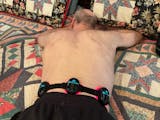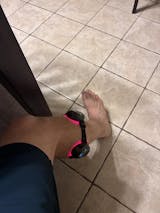Neck pain can strike unexpectedly and disrupt your day. Whether it’s caused by poor posture, overuse, or an injury, finding fast relief is essential. While there are various ways to address neck pain, many people turn to simple home remedies, exercises, and advanced treatments like
red light therapy at home full body. In this article, we’ll cover the most effective strategies to quickly alleviate neck pain and prevent it from coming back.
Understanding the Causes of Neck Pain
Neck pain can result from several factors, and understanding the root cause is the first step toward quick relief. Identifying the reason behind your neck pain helps you choose the most effective treatment.
Poor Posture and Sitting Habits
One of the biggest contributors to neck pain is poor posture, especially from sitting at a desk for long periods. When your head juts forward or you hunch over, it places a strain on your neck muscles and spine. Over time, this can cause stiffness, discomfort, and even chronic pain. To avoid this, make sure your computer screen is at eye level and that you sit upright with your shoulders back.
Muscle Strain and Tension
If you've ever slept in an awkward position or worked for hours without taking a break, you’ve probably experienced muscle strain in your neck. Tension and tightness can build up quickly, especially if you’re stressed. Regular stretching and relaxation exercises can help release this tension and provide relief.
Whiplash or Injury
A sudden impact, like from a car accident or a sports injury, can cause whiplash, which leads to painful muscle spasms in the neck. While these injuries often heal with rest and care, the pain can be intense at first. If you’ve been in an accident or experienced a sudden jolt, it’s important to seek medical advice.
Degenerative Conditions
As we age, degenerative conditions like arthritis or disc issues can affect the neck. These conditions may cause pain, stiffness, and limited mobility. In some cases, these conditions require professional treatment, but lifestyle changes like proper posture and regular exercise can significantly help manage symptoms.
The Role of Red Light Therapy in Treating Neck Pain
How Red Light Therapy Works
Red light therapy uses low-level wavelengths of light to penetrate the skin, reducing inflammation and promoting blood circulation. The energy from the light stimulates cells, encouraging tissue repair and alleviating pain. This therapy can be a fast and non-invasive way to treat neck pain effectively.
Benefits for Neck Pain
red light therapy machine is especially effective for neck pain because it targets the underlying inflammation and encourages healing at the cellular level. By increasing circulation, it helps deliver oxygen and nutrients to the affected areas, speeding up recovery. Whether you’re dealing with muscle tension or inflammation, this therapy can be a fast, drug-free solution.
Choosing the Right Medical-Grade Red Light Therapy Device
-
Consider the Wavelength: Choose a device that emits the correct wavelength, typically between 600 and 650 nanometers, for optimal therapeutic effects.
-
Check the Quality of Light: Ensure the device provides high-quality, consistent light output to achieve effective results.
-
Evaluate the Power Output: Higher power output can lead to faster and more effective treatment, but it should be safe for use.
-
Look for Safety Features: Ensure the device has built-in safety features to prevent any harm during use.
-
Assess the Device's Durability: Choose a device that is built to last, especially if you plan to use it frequently.
-
Consider the Treatment Area Size: A larger treatment area may require a device with a bigger light panel or multiple devices.

Quick Home Remedies for Immediate Neck Pain Relief
If your neck pain is sudden and you need relief fast, there are several home remedies you can try before seeking professional help.
Ice or Heat Application
Applying ice to the neck can help reduce swelling and numb the area, providing quick relief. If you’re dealing with muscle stiffness, applying heat can help relax the muscles and increase blood flow to the area. Both heat and ice therapy are effective in managing pain and inflammation, so alternate between them depending on your comfort.
Gentle Neck Stretches
Simple neck stretches can help relieve tension and improve mobility. Try slowly tilting your head forward, backward, and side to side. Gently turning your neck from left to right can also help loosen tight muscles. Be sure to move slowly and avoid overexerting yourself, especially if the pain is severe.
Over-the-Counter Pain Relief
Over-the-counter medications like ibuprofen or acetaminophen can help reduce pain and inflammation. While these won’t address the underlying issue, they can provide temporary relief, allowing you to move and stretch more comfortably. Always follow the instructions and avoid overuse.
Exercises to Strengthen Your Neck and Prevent Future Pain
Once your neck pain has subsided, it’s important to strengthen the muscles around your neck to prevent future issues.
Neck Flexion and Extension Exercises
Neck flexion and extension exercises involve gently tilting your head forward and backward. These movements help strengthen the muscles in your neck and improve their range of motion. Start slowly and gradually increase the range as your muscles become stronger.
Shoulder Shrugs and Rolls
Shoulder shrugs and rolls can help relieve tension in the upper back and shoulders, areas that can contribute to neck pain. Simply shrug your shoulders up toward your ears and then release them. Shoulder rolls, where you rotate your shoulders forward and backward, are also effective for relieving tension.
Chin Tucks
Chin tucks are a great exercise for strengthening neck muscles and improving posture. To perform a chin tuck, gently pull your chin toward your chest, creating a double chin. Hold for a few seconds, then release. This exercise can help prevent future neck pain by improving your posture and relieving strain.
When to Seek Medical Attention for Neck Pain
While many cases of neck pain can be managed at home, there are times when you should seek medical advice.
Persistent or Severe Pain
If your neck pain lasts for more than a few days or if it’s particularly severe, it’s important to consult a doctor. Chronic pain may indicate an underlying issue that requires professional treatment, such as physical therapy, injections, or even surgery.
Numbness or Tingling
Numbness or tingling sensations that radiate down your arms can be a sign of nerve compression. If you experience these symptoms, it's best to consult with a healthcare provider to rule out more serious conditions like herniated discs or nerve damage.
Pain After an Injury
If you’ve recently been involved in an accident or experienced a sudden injury, it’s crucial to see a doctor. Injuries to the neck, such as whiplash, can cause long-term damage if not properly treated.
Lifestyle Changes to Prevent Neck Pain in the Future
Preventing neck pain is just as important as treating it. Adopting healthier habits can help keep your neck pain-free for the long term.
Improving Posture
Maintaining proper posture is one of the most effective ways to prevent neck pain. When sitting, keep your shoulders relaxed, your back straight, and your head aligned with your spine. If you spend a lot of time sitting, invest in an ergonomic chair that supports your neck and back.
Ergonomic Workstation Setup
Your workstation setup can have a significant impact on your neck health. Ensure that your computer screen is at eye level, and use a chair that provides support to your lower back. Take frequent breaks to avoid sitting in one position for too long.
Regular Breaks and Movement
Take breaks every 30 minutes to stand, stretch, or walk around. This will relieve tension in your neck and back muscles and reduce the risk of developing pain from prolonged sitting.
Conclusion
Neck pain is often bothersome, but it can be effectively relieved with the right methods. Whether using medical-grade red light therapy equipment, performing neck exercises, or adjusting lifestyle habits, these methods can help reduce pain and control symptoms. Protecting your neck can effectively prevent long-term discomfort.
Red light therapy panels are suitable for large-area treatments, while
red light therapy masks focus on facial care, acting on multiple facial areas simultaneously. They are particularly ideal for anti-aging, soothing, repairing, and improving skin texture.





















Share:
How to Relieve Rotator Cuff Pain at Night
How to Start Working out Again After Knee Injury